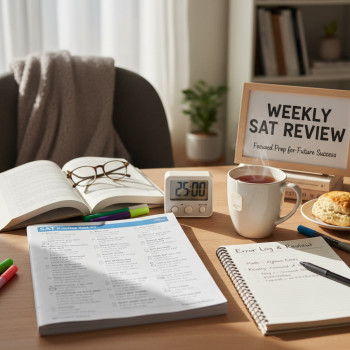Why personalization matters for the Digital SAT
Studying for the Digital SAT is not a one-size-fits-all sprint — it’s a carefully paced marathon. Two students can spend the same hours studying and get completely different results because their strengths, gaps, routines, and stress responses are different. That’s where a personalized strategy shines: it transforms wasted effort into smart effort, helps you gain confidence faster, and keeps burnout at bay.
Think smart, not just hard
Personalized prep means you target the exact skills and question types that move your score. Instead of randomly drilling practice problems, you identify the high-leverage areas — the few things that, when improved, return the biggest score gains. This approach saves time and keeps motivation high because every session feels meaningful.
Step 1 — Start with a clear baseline: diagnostic testing
The first step in any smart plan is to know where you are. Take an official-style diagnostic test under realistic conditions: timed sections, quiet environment, and the full test length. The Digital SAT has unique timing and format elements; simulating that experience gives reliable data you can build on.
How to run an effective diagnostic
- Pick a quiet block of time (3 hours including breaks) and treat it like a real test day.
- Use a timer and follow test rules for notes and calculator usage.
- When you finish, resist the urge to immediately retake — analyze results first.
From the diagnostic, create a simple score map: overall score, section subscores, and top 5 recurring mistakes (for example: algebra word problems, data interpretation, author’s purpose questions, time pressure in Reading, or calculator dependency in Math).
Step 2 — Convert results into readable goals
Now that you know your starting point, translate that into motivating, measurable goals. Don’t say “get better at math.” Say “raise Math score by 60 points in 12 weeks by mastering linear equations and data interpretation.” Specific goals give you something to measure each week.
SMART goals for SAT prep
- Specific: Which skills will you improve?
- Measurable: How many points or what accuracy rate will you reach?
- Achievable: Are you giving yourself enough time and resources?
- Relevant: Does the goal align with college aspirations?
- Time-bound: When will you reassess?
Step 3 — Build a study schedule that fits your life
A lot of students sabotage themselves with an unrealistic calendar. The trick is to map study to what you actually have — not to what you wish you had. A steady, consistent plan beats fits-and-starts every time.
Weekly plan sample
Here’s a flexible weekly template for students balancing school, activities, and social life. Adjust frequency and duration to suit you.
| Day | Focus | Duration | Goal |
|---|---|---|---|
| Monday | Targeted Math practice | 60 minutes | Master one concept + 15 practice problems |
| Tuesday | Evidence-based Reading strategies | 50 minutes | 3 passages with timing practice |
| Wednesday | Grammar and Writing | 40 minutes | Error pattern review + 20 questions |
| Thursday | Full section simulation (Math/Reading) | 60–80 minutes | Build stamina and timing |
| Friday | Review + targeted weak-area practice | 45 minutes | Fix recurring mistakes |
| Weekend | Full practice test or tutor session | 3–4 hours | Measure progress and recalibrate |
Consistency matters more than intensity. Two 45-minute focused sessions per weekday and one long session on the weekend will beat sporadic 5-hour cram days.
Step 4 — Targeted practice: fix the habits behind mistakes
Practice without purpose is busywork. Turn every wrong answer into a mini-investigation: why did I miss it? Was it content, careless error, or timing? That root cause becomes your next micro-lesson.
A practical error-analysis routine
- Copy the question and your answer into a notebook.
- Annotate why the correct answer is right and why your answer was wrong.
- Write a 1–2 sentence rule or strategy you’ll use next time.
- Schedule 2–3 problems of the same type in your next session to reinforce learning.
Step 5 — Use timed practice strategically
Timothy, a fictional junior, made a common mistake: he always practiced untimed. When test day arrived, he froze under time pressure. Timed practice should be introduced progressively—start by timing individual passages or question sets, then build up to full sections, and finally, take full-length digital practice tests.
Timing drills you can try
- Passage sprints: 12–15 minutes per long reading passage to improve reading pace.
- Focused 10-minute math drills: speed on common algebra operations.
- End-of-section push: simulate the last 10 questions of a section to practice finishing strong.
Step 6 — Mix active learning techniques
Active learning beats passive reading. Here are techniques that help the brain retain more efficiently.
Active methods to include
- Teach-back: explain a concept to a peer or record yourself explaining it aloud.
- Spaced repetition: revisit tricky rules and formulas on a predictable schedule.
- Interleaving: switch between different problem types in a session to build flexible thinking.
- Self-quizzing: close the book and force recall — it’s more effective than rereading.
Step 7 — Practice tests: how often and what to do with results
Full-length practice tests are your north star. They measure stamina, timing, and real progress. But it’s the analysis afterward — not the score itself — that yields improvement.
When to take practice tests
- Initial diagnostic: week 0.
- Early benchmark: after 3–4 weeks to check momentum.
- Regular cadence: every 2–3 weeks during active prep.
- Final rehearsals: 2–3 full tests in the final month, spaced out.
After each test, create a short report: change in score by section, most frequent error types, time management wins/losses, and one concrete plan for the next two weeks. This keeps practice tightly connected to growth.
Step 8 — Use technology and tools wisely
Digital prep tools are powerful when used deliberately. Adaptive practice platforms that identify weaknesses and present targeted drills can accelerate learning. If you use such tools, treat their diagnostics and reports as data — not as a replacement for thoughtful planning.
For students wanting extra structure, personalized tutoring can be extremely helpful. Sparkl’s personalized tutoring, for example, pairs 1-on-1 guidance with tailored study plans and expert tutors who translate data into actionable next steps. The right tutor keeps you accountable, explains tricky concepts clearly, and helps you practice the soft skills of test-taking like pacing and anxiety management.
Step 9 — Build test-day routines and psychological readiness
Test day isn’t just academic — it’s emotional. How you manage sleep, meals, and breathing matters. Create a test-day routine well before test day and rehearse it.
Test-day checklist
- Night before: 7–9 hours of sleep. Avoid last-minute cramming.
- Morning of: a balanced breakfast with protein and complex carbs.
- Arrival: get to your test center early (or set up your digital device area) so you can settle in.
- During the test: use a breathing anchor when stress spikes — inhale for 4, hold 2, exhale 6.
Step 10 — Iterate: measure, adjust, and repeat
Study plans aren’t static. Each practice test and session should feed back into your plan. If a strategy isn’t working in two weeks, tweak it. If a tutor or a new resource is helping, lean into it. The most successful students continuously iterate until their plan fits them snugly.
Quarterly review template (every 3–4 weeks)
- Score trends: Which sections are improving and which are stuck?
- Error taxonomy: Are mistakes content-based, careless, or timing-related?
- Time allocation: Is your weekly schedule addressing the right gaps?
- Emotional check: Are you motivated, burned out, or anxious?
Examples: Two personalized plans that fit different students
Seeing sample plans helps translate theory into practice. Here are two compact examples.
Case A — Maya: Busy senior with strong Reading, needs Math boost
- Baseline: 1220 (Reading 660, Math 560)
- Goal: +120 points overall, focus on Math (+80)
- Plan highlights: 3 Math sessions/week (60 minutes), weekly targeted algebra reviews, weekend full test every 2 weeks, monthly tutor check-in to refine strategies.
- Why it fits: Short, intense math sessions that fit around APs and extracurriculars, with the tutor pulling together targeted problem sets.
Case B — Javier: Junior with sporadic study habits, small time budget
- Baseline: 1050 (Reading 520, Math 530)
- Goal: +180 points in 5 months
- Plan highlights: Daily 30–40 minute micro-sessions (alternating Reading and Math), spaced repetition flashcards for key grammar and formulas, monthly full tests, weekly 1-hour tutor sessions for accountability and strategy.
- Why it fits: Frequent short sessions build consistency; tutoring provides structure and momentum.
Practical resources to include in your plan
Collect a small, high-quality toolbox and avoid drowning in materials. Choose trusted practice tests, a credible adaptive practice platform, a solid grammar workbook, and a tutor or coach if you benefit from guided accountability.
| Resource Type | Purpose | How often to use |
|---|---|---|
| Official-style full practice tests | Measure progress and build stamina | Every 2–3 weeks |
| Adaptive practice platform | Targeted drills for weak spots | 3–5 sessions/week |
| Grammar workbook | Master writing rules and common errors | 2–3 sessions/week |
| 1-on-1 tutoring | Personalized feedback and accountability | Weekly or biweekly |
Small habits that compound into big improvements
Great SAT prep isn’t only what happens during study time — it’s the daily habits that support learning.
Build these habits
- Reflect for 5 minutes after each session: What did you learn and what’s next?
- Keep a simple error log that you review weekly.
- Practice active reading every day: annotate an article and summarize the main idea in one sentence.
- Sleep, hydration, and movement: 20–30 minutes of light exercise improves focus and memory.
When to get personalized help — and what to expect
If you’re two months out and not seeing steady progress, or if you need help turning diagnostic data into a practical plan, personalized help is a good next step. A tutor can diagnose subtle root causes — like inefficient problem selection, pacing habits, or anxiety patterns — and give you step-by-step corrections.
With expert tutoring, especially when combined with data-driven tools, you get:
- 1-on-1 guidance tuned to your learning style.
- Tailored study plans that evolve with your progress.
- Expert strategies for the toughest question types.
- Accountability that keeps momentum going.
For students who appreciate structure, Sparkl’s personalized tutoring blends these elements — expert tutors, tailored plans, and AI-driven insights that highlight the highest-impact next steps. That combination often helps students close stubborn score gaps faster.
Common pitfalls and how to avoid them
Even a good plan can be derailed. Here are common traps and quick fixes.
Trap 1: Overemphasis on quantity
Fix: Swap low-value hours for high-quality targeted sessions. One focused hour of deliberate practice beats three hours of passive review.
Trap 2: Ignoring pacing and stamina
Fix: Simulate test timing regularly and practice the final stretch of each section where fatigue shows up.
Trap 3: Chasing unfamiliar question types too soon
Fix: Solidify fundamentals first, then expand into trickier items. Build a foundation of reliable strategies before running advanced drills.
Final month: taper, review, and rehearse
In the last four weeks, shift from learning new content to sharpening strategies, doing realistic practice tests, and rehearsing test-day logistics. Reduce the volume slightly to keep energy high and make each session intentional.
Two-week rehearsal checklist
- Take one final full practice test each week.
- Work on pacing by section — practice finishing every section comfortably.
- Refine your test-day routine: sleep, breakfast, and timing strategy.
- Light review of your error log, focusing on the 10–15 most frequent mistakes.
Parting advice: make the journey yours
Personalized prep is less about copying someone else’s schedule and more about listening to your progress signals. Use diagnostics to choose targets, make a schedule you can keep, practice deliberately, and iterate until your plan feels natural. If you find yourself stuck, a tutor can translate confusion into concrete next steps — Sparkl’s personalized tutoring is one example of support that pairs human coaching with tailored plans and insights.
Above all, remember that this is a skill-building process. The study habits and problem-solving habits you develop for the Digital SAT will help you in college and beyond. Treat the prep like training: small, steady improvements add up into meaningful growth.
Quick-start checklist (printable)
- Take an initial diagnostic test this week.
- Set one clear, time-bound score goal.
- Create a weekly schedule you can realistically follow.
- Do targeted practice for your top 3 weaknesses.
- Take full practice tests every 2–3 weeks and analyze results.
- Consider personalized tutoring if progress stalls.
- Practice test-day routines and manage stress with simple breathing techniques.
Closing thought
Preparing for the Digital SAT is an opportunity to learn how you learn. When you craft a plan that’s tailored to your strengths, schedule, and goals, every study minute becomes an investment. Keep your plan flexible, be honest with your progress, and ask for help when you need it — the right support and the right strategy can transform steady effort into the score you want.

















No Comments
Leave a comment Cancel